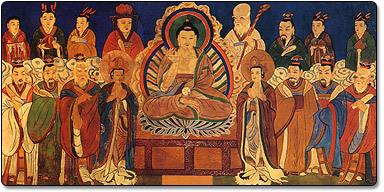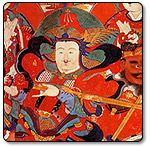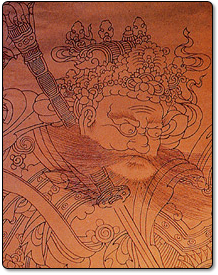|


Behind
the main statue in the main hall there is usually a large
mural. These are added to give a clearer, more complete
image of the Buddhist cosmic view to the visitor. Depending
on the size and nature of the hall, murals are more or
less complex arrangements of figures taken from a variety
of specific, traditional designs.

If
you look closely, you will find all kinds of interesting
personalities peering out. Amitabha is the most frequent
central figure to be found, and usually he is shown with
rays of light coming from his head. In the foreground,
towards the bottom left and right corners, there are usually
guardians.
 Bodhisattvas
are often placed nearer to the feet of the principal figure
and, in the middle, there are the gods and ordinary people. Bodhisattvas
are often placed nearer to the feet of the principal figure
and, in the middle, there are the gods and ordinary people.
Above,
often near the main Buddha's head, there are monks. Look
for an old-looking one, Kasyapa, and a younger one, the
Buddha Sakyamuni's attendant Ananda. Apart from the main
mural behind the statue, there are numerous other protector
paintings. These depict beings that are more human in
appearance; they represent the human world of desire.
Many
earth/sky gods, derived from Indian religions as well
as Taoist spirits and Confucian characters, are all included
in Korean Buddhist iconography.
 Other
popular Buddhist paintings in the main hall feature the
Dragon King, who is easily identified by his outlandish
eyebrows and mustache, and the Bodhisattva Tongjin. As
protector of the Dharma and the Lotus Sutra in particular,
Tongjin is often the centre of a protector painting and
can be identified by his sword and rather ostentatiously
feathered headgear. Other
popular Buddhist paintings in the main hall feature the
Dragon King, who is easily identified by his outlandish
eyebrows and mustache, and the Bodhisattva Tongjin. As
protector of the Dharma and the Lotus Sutra in particular,
Tongjin is often the centre of a protector painting and
can be identified by his sword and rather ostentatiously
feathered headgear.
In
separate, smaller shrines look for the delightful Mountain
Spirit painting. As the resident spirit long before Buddhism
arrived in Korea, the Mountain Spirit is always flanked
by a friendly tiger and by an attendant. Often the painting
has great charm and character, as do those of the Seven
Star Spirit (Big Dipper) and the Recluse.
Son
Art
Son
Art (Son is the Korean form of Ch'an/Zen) tries to communicate
visually what speech often fails to do - the true nature
of reality, the experience of which is the goal of Son.
This is done through spontaneity, included in the Buddhist
values incorporated in the training.
Mastering
the brush may take years, even decades of persevering
practice in order to achieve patience, and perfection.
Then spontaneity is added...
Son
painting is completely unpredictable, except for Bodhidharma
and the Oxherding Pictures. In Korea this abbreviated
form of Buddhist art has drawn new interest in recent
years.

|
